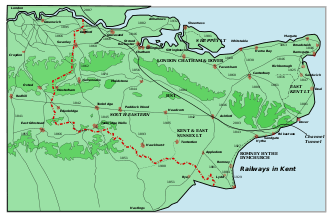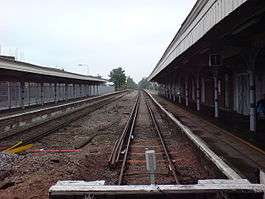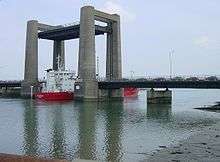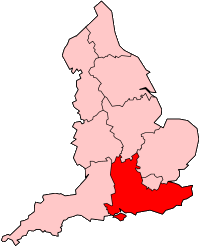Sheerness line
The Sheerness line is located in Kent, England, and connects Sheerness-on-Sea on the Isle of Sheppey with Sittingbourne on the mainland, and with the Chatham Main Line for trains towards London, Ramsgate or Dover Priory. It opened on 19 July 1860.
| Sheerness line | |
|---|---|
| Overview | |
| Type | Suburban rail, Heavy rail |
| System | National Rail |
| Status | Operational |
| Locale | Kent South East England |
| Termini | Sheerness-on-Sea Sittingbourne |
| Operation | |
| Owner | Network Rail |
| Operator(s) | Southeastern |
| Rolling stock | Class 375 (Typical) Class 465 Class 466 |
| Technical | |
| Track gauge | 1,435 mm (4 ft 8 1⁄2 in) standard gauge |
| Operating speed | 75 mph (121 km/h) |
Sheerness line | ||||||||||||||||||||||||||||||||||||||||||||||||||||||||||||||||||||||||||||||||||||||||||||||||||||||||||||||||
|---|---|---|---|---|---|---|---|---|---|---|---|---|---|---|---|---|---|---|---|---|---|---|---|---|---|---|---|---|---|---|---|---|---|---|---|---|---|---|---|---|---|---|---|---|---|---|---|---|---|---|---|---|---|---|---|---|---|---|---|---|---|---|---|---|---|---|---|---|---|---|---|---|---|---|---|---|---|---|---|---|---|---|---|---|---|---|---|---|---|---|---|---|---|---|---|---|---|---|---|---|---|---|---|---|---|---|---|---|---|---|---|---|
| ||||||||||||||||||||||||||||||||||||||||||||||||||||||||||||||||||||||||||||||||||||||||||||||||||||||||||||||||
Mileage measured from London Victoria | ||||||||||||||||||||||||||||||||||||||||||||||||||||||||||||||||||||||||||||||||||||||||||||||||||||||||||||||||



History
The Sheerness branch line opened on 19 July 1860,[1] from Sittingbourne to, at first, a station in the Blue Town area of Sheerness, close to the southern edge of the Royal Navy dockyard. In 1883 a further station was added at Sheerness-on-Sea, accessed by a reversing curve from the original station, which was renamed Sheerness Dockyard. At this time, all trains had to run first to the Dockyard station, then reverse (after the engine had changed ends) to Sheerness-on-Sea, and vice versa for the return journey. The original line was built by the independent Sittingbourne and Sheerness Railway company, and taken over by the London, Chatham & Dover Railway (LC&DR) in 1876. After 1899, it was run by the South Eastern & Chatham Railway, formed by the working union of the LC&DR with the South Eastern Railway. In 1902 the so-called Navy Tram Road was constructed from the Dockyard station into HM Dockyard for the transfer of good wagons. In 1922 a direct line to Sheerness-on-Sea station was built, bypassing the older station, from which date all passenger trains ran to the newer station, and the Dockyard station was used only by goods trains. Sheerness-on-Sea station remains open, but the Dockyard station was closed to all traffic in about 1968. Its site is now occupied by sidings serving Sheerness Steel, but the former Navy Tram Road still exists. The Royal Navy dockyard closed in 1961, but the rail link was kept in the belief it would continue to serve the new commercial docks on the former Navy site.[2][3] The line was electrified by British Railways on 15 June 1959 as part of the "Kent Coast electrification" in the 1955 Modernisation Plan.[4] In conjunction with electrification double track was introduced between the junction with the main line and near Swale Halt. In 1960 the bridge over the Swale estuary was rebuilt when a slight deviation of the line was built requiring a new platform at Swale Halt on a different alignment.
Accidents and incidents
- On 29 June 1892 a train from Sheerness-on-Sea collided with the buffer stops at Sheerness Dockyard station, injuring nine passengers and the driver. The Westinghouse brake connection between the engine (no. 81, an 0-4-2WT of the LCDR Scotchmen class) and train was closed off due to the negligence of the driver and fireman, and was not checked by the guard. All three men were penalised.[5]
- On 17 December 1922, the Norwegian cargo ship Gyp collided with the Kingsferry Bridge, rendering it unfit to carry rail traffic.[6] The bridge was eventually repaired, and through rail services were restored on 1 November 1923.[7]
- On 26 February 1971, a train formed of five 2HAP electric multiple units overran the buffers and demolished the station building at Sheerness-on-Sea. One person was killed and ten were injured.[8]
Train services
The connection to Sittingbourne faces away from London (Coast Bound), and most trains on the line run as shuttles between the station and Sheerness - there are, however, a few through trains which run directly between Newington station and Kemsley via a connecting curve.
Swale station was earmarked for closure, with the Strategic Rail Authority proposing either a Parliamentary train or complete closure. This plan was eventually rejected, and the station retains a regular service.
Train services on the line are operated by Southeastern.
The typical Monday-Saturday off-peak service consists of two trains per hour in each direction between Sittingbourne and Sheerness-on-Sea, with an hourly service operating on Sundays. As of November 2019, these services are generally run using 3-car Class 375 Electrostar EMUs which have replaced the 2-car Class 466 Networkers, initially due to power issues, but ultimately so the units are fully accessible for disabled passenger in 2020, which would have been brought in on 15 December 2019 with the new timetable anyway.
Class 465s were considered for this line but due to sighting issues for the guard at Swale station, it was decided it would be safer to use the Electrostars as the guard has better control over the doors. Previous units used on this line were 3-car Class 508 Merseyrail EMUs introduced as a stop-gap from 1996 to 2006 to replace the Mk1 Slam Door EMUs.
From the January 2015 timetable change, from Monday to Friday, Southeastern operate two direct services from Sheerness-On-Sea to London Victoria in the morning peak, and two return services from London Victoria to Sheerness On Sea in the evening. These services do not stop at Swale or Sittingbourne, but use the third side of a triangle junction (Western Junction) that links the Sheerness Line to the Chatham Mainline. These are normally operated by Class 465 and 466 Networker formed into 6 car units. Class 466 units on their own are not compatible with the Rail Vehicle Accessibility (Non-Interoperable Rail System) Regulations 2010 (RVAR 2010) as of 1 January 2020, so are used in combination with Class 465 units. At Sheerness-on-Sea, most trains will normally use Platform 1, but due to the shorter length of Platform 2, some Sittingbourne bound services now use Platform 2 to allow the longer Victoria Services to use Platform 1.
In addition to this, there is also one very early morning journey Monday-Friday only which runs from Gillingham to Sheerness-on-Sea. This service also uses the Western Junction to connect to the Sheerness Line directly from the Chatham Main Line. As a result, this service does not stop at Sittingbourne although it does stop at Swale.
150th anniversary
During July 2010 there were events celebrating 150 years of trains to Sheppey, with a plaque on display at Queenborough Station.
Sheppey Light Railway
There was a branch line from Queenborough to Leysdown, opened in 1901 and closed 1950 - see the Sheppey Light Railway.
References
Citations
- White 1976, p. 93.
- Mitchell, Vic; Smith, Keith (July 1993). Branch Lines Around Sheerness. Middleton Press. ISBN 1 873 793 16 2.
- Gray, Adrian (1984). The London, Chatham & Dover Railway. Meresborough Books. ISBN 0905270 886.
- "Branch to Sheerness". Railway Magazine. Vol. 128 no. 971. March 1982. p. 112. ISSN 0033-8923.
- Bradley, D.L. (March 1979) [1960]. The Locomotive History of the London, Chatham & Dover Railway (2nd ed.). London: RCTS. p. 55. ISBN 0 901115 47 9. OCLC 59838998.
- "King's Ferry Bridge seriously damaged". The Times (43217). London. 18 December 1922. col A, p. 9.
- Kidner, R. W. (1985). Southern Railway Halts. Survey and Gazetteer. Headington, Oxford: The Oakwood Press. p. 56. ISBN 0-85361-321-4.
- Moody, G. T. (1979) [1957]. Southern Electric 1909-1979 (Fifth ed.). Shepperton: Ian Allan Ltd. p. 212. ISBN 0 7110 0924 4.
Sources
- White, H.P. (1976). Forgotten Railways : Vol 6 – South-East England. David & Charles. ISBN 0-946537-37-2.CS1 maint: ref=harv (link)
